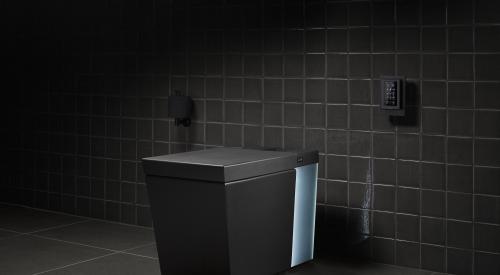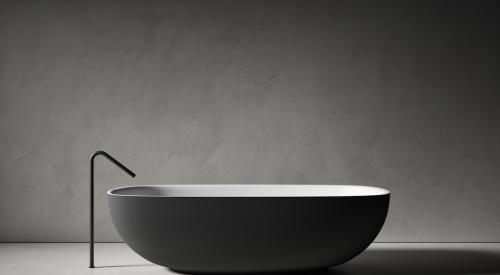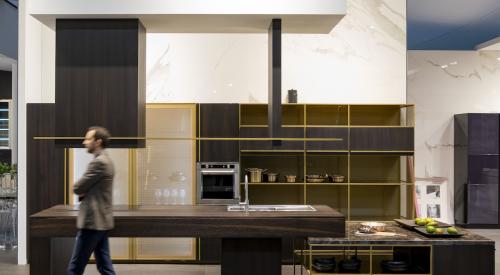One of the most important goals when you’re designing and constructing a house is keeping it dry. That’s because water destroys buildings.
Of course, any construction professional knows that the primary weapon for making sure houses stay dry is a weather barrier. Sometimes called a drainage plane, it permits water vapor to escape from the house but allows wind-driven rain that penetrates the siding to dry out or drain away from the wall.
“By keeping building materials dry, a weather-resistive barrier improves building durability, decreases maintenance costs, and reduces the risk of moisture-related problems such as bugs, mold, mildew, and rot,” Oak Ridge National Laboratory writes.
Fortifiber Building Systems Group
WeatherSmart Drainable channels liquid away from the wall assembly with greater than 95 percent efficiency, the company says. Made from spun-bonded polypropylene fabric with a non-perforated breathable polymer layer, the product resists tears, abrasions, and punctures.
Though no longer prevalent, asphalt-saturated felt or building paper was once the dominant weather barrier, and it’s still effective today. “Felt is still a pretty good housewrap,” says Carl Seville, a former builder and a principal at green consulting firm SK Collaborative. “It’s a little harder to do the flashing around windows and other penetrations, but it’s not a bad product.”
Plastic-based housewrap is now the primary option for most contractors. The product is widely available from many brands, such as DuPont Tyvek, GreenGuard Classic Wrap, Owens Corning Pink Wrap, Avintiv Typar, Barricade Building Products R-Wrap, and Cosella-Dörken Delta-Vent S, among many others. They all aim to accomplish the same goal: to keep houses dry.
Manufacturers are finding clever ways to move beyond the traditional housewrap product. DuPont, for example, has added a breathable Tyvek ThermaWrap R5.0 product that offers air and water protection, but it also adds an R-value of 5 to the wall.
Tyvek HomeWrap is a traditional housewrap that helps keep air and water out but allows water vapor to escape. The nonwoven product is breathable, promoting drying in wall systems and preventing mold and water damage. It’s available in 9- and 10-foot-wide rolls.
There’s another path, as well: all-in-one structural sheathing with an integrated weather barrier. Introduced by Huber Engineered Woods, the ZIP System consists of structural panels with a factory-applied membrane and a high-performance tape for the seams. (It resists liquid water, but it’s vapor permeable, the manufacturer says.) The two-step installation system results in a 40 percent time savings. And some years ago, Huber updated the product line with ZIP System R Sheathing, adding a continuous foam insulation layer that increases the thermal performance and creates a continuous rigid air barrier for better energy efficiency.
ZIP System R Sheathing “answers a call from builders to make the construction process more effi cient while helping meet stricter energy codes that require continuous exterior insulation,” Brent Flotkoetter, ZIP System product director, says.
Huber now has competition. Georgia-Pacific recently unveiled its own all-in-one system, the ForceField Air and Water Barrier System. Designed to keep water out of a structure during and after construction, ForceField also consists of engineered wood sheathing panels laminated with an air and water barrier.
ForceField consists of engineered wood panels laminated with an air and water barrier. Once the panels are applied, the joints are taped with ForceField seam tape, eliminating the need for housewrap. Panels measure 7 /16-inch thick and come in three lengths.
“We saw a need for an alternative to housewrap, so we engineered something that we think works very well,” says Jeff Key, marketing manager for Georgia-Pacific. “Early feedback from builders has been positive.”
Like ZIP System, ForceField wall sheathing is installed like traditional panels and the joints are taped, creating an air and water barrier and eliminating the need for housewrap.
The company claims a time savings of up to 37 percent versus housewrap. Key acknowledges that there are competitors on the market but says the company positions the product against housewrap. Building science consultants give all-in-one systems favorable reviews, but they are also fans of liquid-applied products, such as StoGuard by Sto Corp. The product can be sprayed on or rolled on and dries to form a moisture-proof weather barrier. “This reduces the risk of improper installation, which can lead to moisture intrusion problems,” the company says.
StoGuard is a fluid-applied weather barrier that’s faster and easier to install than traditional housewraps. The product can be sprayed on or applied with a roller, which reduces the number of penetrations and minimizes the potential for moisture and air infiltration.
Seville, who is a fan of the ZIP System, also likes fluid-applied products. “The fluid-applied products are very good, but you don’t see them that much in residential,” he says. “They’re kind of costly.”
GreenBuildingAdvisor.com agrees, but adds: “Although liquidapplied water -resistive barriers cost more than housewrap, they also perform better. If air tightness is important to you, and your construction budget can handle the cost, a liquid-applied WRB may make sense.”
No matter the system, it works best when it’s installed properly. If done right, your houses will stay dry for years to come.
This story originally appeared in the Spring 2016 issue of PRODUCTS magazine. See the print version here.

















